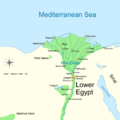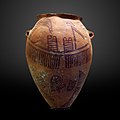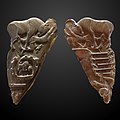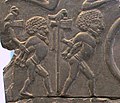Portal:Ancient Egypt
|
THE ANCIENT EGYPT PORTAL
Showcased content about Ancient Egypt Ancient Egypt was a cradle of civilization concentrated along the lower reaches of the Nile River in Northeast Africa. It emerged from prehistoric Egypt around 3150 BC (according to conventional Egyptian chronology), when Upper and Lower Egypt were amalgamated by Menes, who is believed by the majority of Egyptologists to have been the same person as Narmer. The history of ancient Egypt unfolded as a series of stable kingdoms interspersed by the "Intermediate Periods" of relative instability. These stable kingdoms existed in one of three periods: the Old Kingdom of the Early Bronze Age; the Middle Kingdom of the Middle Bronze Age; or the New Kingdom of the Late Bronze Age. The pinnacle of ancient Egyptian power was achieved during the New Kingdom, which extended its rule to much of Nubia and a considerable portion of the Levant. After this period, Egypt entered an era of slow decline. Over the course of its history, it was invaded or conquered by a number of foreign civilizations, including the Hyksos, the Kushites, the Assyrians, the Persians, and, most notably, the Greeks and then the Romans. The end of ancient Egypt is variously defined as occurring with the end of the Late Period during the Wars of Alexander the Great in 332 BC or with the end of the Greek-ruled Ptolemaic Kingdom during the Roman conquest of Egypt in 30 BC. In AD 642, the Arab conquest of Egypt brought an end to the region's millennium-long Greco-Roman period. The success of ancient Egyptian civilization came partly from its ability to adapt to the Nile's conditions for agriculture. The predictable flooding of the Nile and controlled irrigation of its fertile valley produced surplus crops, which supported a more dense population, and thereby substantial social and cultural development. With resources to spare, the administration sponsored the mineral exploitation of the valley and its surrounding desert regions, the early development of an independent writing system, the organization of collective construction and agricultural projects, trade with other civilizations, and a military to assert Egyptian dominance throughout the Near East. Motivating and organizing these activities was a bureaucracy of elite scribes, religious leaders, and administrators under the control of the reigning pharaoh, who ensured the cooperation and unity of the Egyptian people in the context of an elaborate system of religious beliefs.[1] Among the many achievements of ancient Egypt are: the quarrying, surveying, and construction techniques that supported the building of monumental pyramids, temples, and obelisks; a system of mathematics; a practical and effective system of medicine; irrigation systems and agricultural production techniques; the first known planked boats; Egyptian faience and glass technology; new forms of literature; and the earliest known peace treaty, which was ratified with the Anatolia-based Hittite Empire. Its art and architecture were widely copied and its antiquities were carried off to be studied, admired, or coveted in the far corners of the world. Likewise, its monumental ruins inspired the imaginations of travelers and writers for millennia. A newfound European and Egyptian respect for antiquities and excavations that began in earnest in the early modern period has led to much scientific investigation of ancient Egypt and its society, as well as a greater appreciation of its cultural legacy. (Full article...) Selected article - The Osiris myth is the most elaborate and influential story in ancient Egyptian mythology. It concerns the murder of the god Osiris, a primeval king of Egypt, and its consequences. Osiris's murderer, his brother Set, usurps his throne. Meanwhile, Osiris's wife Isis restores her husband's body, allowing him to posthumously conceive their son, Horus. The remainder of the story focuses on Horus, the product of the union of Isis and Osiris, who is at first a vulnerable child protected by his mother and then becomes Set's rival for the throne. Their often violent conflict ends with Horus's triumph, which restores maat (cosmic and social order) to Egypt after Set's unrighteous reign and completes the process of Osiris's resurrection. The myth, with its complex symbolism, is integral to ancient Egyptian conceptions of kingship and succession, conflict between order and disorder, and especially death and the afterlife. It also expresses the essential character of each of the four deities at its center, and many elements of their worship in ancient Egyptian religion were derived from the myth. (Full article...) Selected picture
Map of the Giza pyramid complex, located 20 km (12.5 mi) southwest of Cairo, Egypt. This Ancient Egyptian necropolis consists of the Great Pyramid, the Pyramid of Khafre, and the Pyramid of Menkaure, along with a number of smaller satellite edifices, known as "queens" pyramids, causeways and valley pyramids, and most noticeably the Great Sphinx. The site has attracted visitors and tourists since classical antiquity, when these Old Kingdom monuments were already over 2,000 years old. Did you know...
News5th September 2018. Rock-cut Tomb discovered in a 4,000-year-old Elite Cemetery August 2018: in the tomb of the mayor of Memphis Ptahmose who dates around 1300 BC was found well preserved cheese, more than 3000 years old. [1] Selected biography -Ptolemy II Philadelphus (Ancient Greek: Πτολεμαῖος Φιλάδελφος, Ptolemaîos Philádelphos, "Ptolemy, sibling-lover"; 309 – 28 January 246 BC) was the pharaoh of Ptolemaic Egypt from 284 to 246 BC. He was the son of Ptolemy I, the Macedonian general of Alexander the Great who founded the Ptolemaic Kingdom after the death of Alexander, and Queen Berenice I, originally from Macedon. During Ptolemy II's reign, the material and literary splendour of the Alexandrian court was at its height. He promoted the Museum and Library of Alexandria. In addition to Egypt, Ptolemy's empire encompassed much of the Aegean and Levant. He pursued an aggressive and expansionist foreign policy with mixed success. From 275 to 271 BC, he led the Ptolemaic Kingdom against the rival Seleucid Empire in the First Syrian War and extended Ptolemaic power into Cilicia and Caria, but lost control of Cyrenaica after the defection of his half-brother Magas. In the Chremonidean War (c. 267–261 BC), Ptolemy confronted Antigonid Macedonia for control of the Aegean and suffered serious setbacks. This was followed by a Second Syrian War (260–253 BC) against the Seleucid empire, in which many of the gains from the first war were lost. (Full article...) General imagesThe following are images from various ancient Egypt-related articles on Wikipedia.
Related portalsWikiProjectsMain topics
Notable Pharaohs
CategoriesRecognized content
Featured articles
Featured listsGood articles
Did you know? articles
Featured pictures
In the News articlesMain page featured articles
Main page featured listsPicture of the day pictures
Things to do
WikimediaThe following Wikimedia Foundation sister projects provide more on this subject:
Sources
Discover Wikipedia using portals |








































































